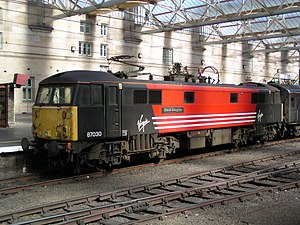British Rail Class 87
British Rail Class 87

87030 Black Douglas in Virgin Trains livery at Carlisle in 2004. |
|
|
|
|
| Performance figures |
| Maximum speed |
110 mph (180 km/h) |
Power output:
|
|
| • 1 hour |
1,270 hp (950 kW) per motor |
| • Continuous |
- 5,000 hp (3,700 kW) (87/0)
- 4,850 hp (3,620 kW) (87/1)
|
| Tractive effort |
58,000 lbf (258 kN) |
| Loco brakeforce |
40 long tons (41 t) |
|
|
|
| Performance figures |
| Maximum speed |
110 mph (180 km/h) |
Power output:
|
|
| • 1 hour |
1,270 hp (950 kW) per motor |
| • Continuous |
- 5,000 hp (3,700 kW) (87/0)
- 4,850 hp (3,620 kW) (87/1)
|
| Tractive effort |
58,000 lbf (258 kN) |
| Loco brakeforce |
40 long tons (41 t) |
The British Rail Class 87 is a type of electric locomotive built in 1973–75 by British Rail Engineering Limited. Thirty-six of these locomotives were built to work passenger services over the West Coast Main Line (WCML). They were the flagships of British Rail's electric locomotive fleet until the late 1980s, when the Class 90s started to come on stream. The privatisation of British Rail saw all but one of the fleet transferred to Virgin Trains. They continued their duties until the advent of the new Class 390 Pendolinos, when they were transferred to other operators or withdrawn. There is only one Class 87 still in use in Britain, 87002, owned by the AC Locomotive Group and solely used alongside 86101 for the occasional charter train. A large proportion of the fleet have now been exported to Bulgaria. 87002 is currently hired by Serco to work the empty coaching stock of the Caledonian Sleeper services.
A requirement for more electric locomotives came about after the electrification of the WCML was extended from Weaver Junction north of Crewe to Preston, Carlisle and Glasgow. Initially, three Class 86 locomotives were used as test-beds to trial equipment (mainly electrical equipment and suspension) that would be used in the new locomotives; effectively, these locomotives were Class 87s in everything but appearance.
The external design of the Class 87 was clearly derived from that of the Class 86; the only major detail differences were two front cab windows on the 87 instead of the three of the 86, and also the lack of headcode indicator boxes; by 1973, visual recognition of train reporting numbers by signallers was no longer necessary. The power and speed of the Class 87 was increased over that of the Class 86. Power output was increased to 5000 hp to deal with the more demanding gradients on the northern half of the WCML such as Shap Fell and , and the top speed was raised to 110 mph (180 km/h). The 87s were also fitted with multiple working equipment which enabled locomotives to work with other members of the class (and some Class 86s) while controlled by one driver.
...
Wikipedia

